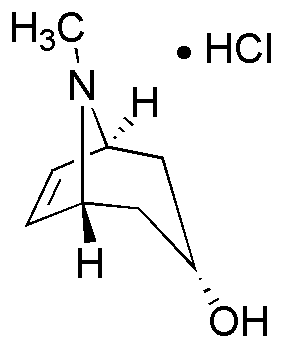Tropenol hydrochloride is widely utilized in research focused on:
- Pharmaceutical Development: This compound serves as a key intermediate in the synthesis of various pharmaceuticals, particularly in the development of medications targeting neurological disorders.
- Aromatherapy and Fragrance Industry: Its unique scent profile makes it a valuable ingredient in perfumes and aromatherapy products, enhancing sensory experiences.
- Biochemical Research: Researchers use tropenol hydrochloride to study its effects on neurotransmitter systems, providing insights into brain function and potential therapeutic applications.
- Insect Repellents: The compound has shown potential as a natural insect repellent, offering a safer alternative to synthetic chemicals in pest control products.
- Flavoring Agent: In the food industry, it can be used as a flavoring agent, contributing to the complexity of taste profiles in various culinary applications.
General Information
Properties
Safety and Regulations
Applications
Tropenol hydrochloride is widely utilized in research focused on:
- Pharmaceutical Development: This compound serves as a key intermediate in the synthesis of various pharmaceuticals, particularly in the development of medications targeting neurological disorders.
- Aromatherapy and Fragrance Industry: Its unique scent profile makes it a valuable ingredient in perfumes and aromatherapy products, enhancing sensory experiences.
- Biochemical Research: Researchers use tropenol hydrochloride to study its effects on neurotransmitter systems, providing insights into brain function and potential therapeutic applications.
- Insect Repellents: The compound has shown potential as a natural insect repellent, offering a safer alternative to synthetic chemicals in pest control products.
- Flavoring Agent: In the food industry, it can be used as a flavoring agent, contributing to the complexity of taste profiles in various culinary applications.
Documents
Safety Data Sheets (SDS)
The SDS provides comprehensive safety information on handling, storage, and disposal of the product.
Product Specification (PS)
The PS provides a comprehensive breakdown of the product’s properties, including chemical composition, physical state, purity, and storage requirements. It also details acceptable quality ranges and the product's intended applications.
Certificates of Analysis (COA)
Search for Certificates of Analysis (COA) by entering the products Lot Number. Lot and Batch Numbers can be found on a product’s label following the words ‘Lot’ or ‘Batch’.
*Catalog Number
*Lot Number
Certificates Of Origin (COO)
This COO confirms the country where the product was manufactured, and also details the materials and components used in it and whether it is derived from natural, synthetic, or other specific sources. This certificate may be required for customs, trade, and regulatory compliance.
*Catalog Number
*Lot Number
Safety Data Sheets (SDS)
The SDS provides comprehensive safety information on handling, storage, and disposal of the product.
DownloadProduct Specification (PS)
The PS provides a comprehensive breakdown of the product’s properties, including chemical composition, physical state, purity, and storage requirements. It also details acceptable quality ranges and the product's intended applications.
DownloadCertificates of Analysis (COA)
Search for Certificates of Analysis (COA) by entering the products Lot Number. Lot and Batch Numbers can be found on a product’s label following the words ‘Lot’ or ‘Batch’.
*Catalog Number
*Lot Number
Certificates Of Origin (COO)
This COO confirms the country where the product was manufactured, and also details the materials and components used in it and whether it is derived from natural, synthetic, or other specific sources. This certificate may be required for customs, trade, and regulatory compliance.


